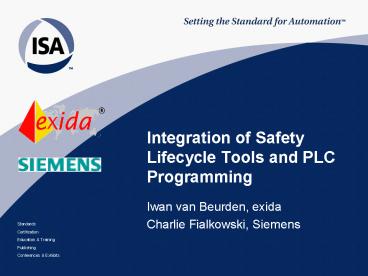Integration of Safety Lifecycle Tools and PLC Programming - PowerPoint PPT Presentation
1 / 15
Title:
Integration of Safety Lifecycle Tools and PLC Programming
Description:
Integration of Safety Lifecycle Tools and PLC Programming. Safety Lifecycle Phases ... Heat used to separate petroleum into various components in distillation column ... – PowerPoint PPT presentation
Number of Views:276
Avg rating:3.0/5.0
Title: Integration of Safety Lifecycle Tools and PLC Programming
1
Integration of Safety Lifecycle Tools and PLC
Programming
- Iwan van Beurden, exida
- Charlie Fialkowski, Siemens
2
Presenters Co-authors
- exida
- Iwan van Beurden, MSc, CFSE
- Senior Safety Engineer
- exSILentia product Manager
- Siemens
- Charlie Fialkowski, CFSE
- Safety System Product Manager
- John Cusimano, CFSE
- Business Development Manager, Process Safety
Systems - Patricia Ela
3
Integration of Safety Lifecycle Tools and PLC
Programming
- Safety Lifecycle Phases
- Example HIPPS
- Safety Lifecycle Engineering Tools
- SIL Selection
- SIL Verification (conceptual design)
- Cause Effect Matrix (detailed design)
- Integration of exSILentia and Safety Matrix
4
ANSI/ISA 84.00.01-2004 Safety Lifecycle
5
Example HIPPS Safety Instrumented Function
- Example Process
- Heat used to separate petroleum into various
components in distillation column - Hazard identified
- Column C-51 Overpressure, with Possible
Overloading of Flare System - Safety Instrumented Function
- High Pressure on Column C-51 Causes Steam Supply
to Reboiler E-52 to Close
6
SIL Selection
- Assume
- Demand frequency
- Over pressure every 3 years
- Consequence
- Single Fatality
- Economic Loss of 4 Million
SIF Item Hazard Description Inputs Outputs Target SIL
SIF 1 Column C-51 overpressure, with possible overloading of flare system. High Pressure on Column C-51 causes Steam Supply to Reboiler E-52 to close. PT-51PT-52PT-53(2oo3) XV-51 CloseXV-52 Close(1oo2) 3
Note Target SIL and input / output voting are
for illustrative examples only and are not to be
taken as typical, suggested or recommended.
7
Conceptual Design (I)
PT-51
2oo3
1oo2
PT-52
Logic Solver
PT-53
XV-51
XV-52
SIF Item Hazard Description Inputs Outputs Target SIL
SIF 1 Column C-51 overpressure, with possible overloading of flare system. High Pressure on Column C-51 causes Steam Supply to Reboiler E-52 to close. PT-51PT-52PT-53(2oo3) XV-51 CloseXV-52 Close(1oo2) 3
Note Target SIL and input / output voting are
for illustrative examples only and are not to be
taken as typical, suggested or recommended.
8
Conceptual Design (II)
9
Detailed Design
10
exSILentia to Safety Matrix Integration Workflow
project.exi exSILentia export file
exSILentia to Safety Matrix Utility
11
SIMATIC Safety Matrix for HIPPS Example
12
The Safety Lifecycle - Objectives
- Build safer systems that do not experience as
many of the problems of the past - Build more cost effective systems that match
design with risk - Eliminate weak link designs that cost much but
provide little - Provide a global framework for consistent designs
13
Summary
- The ANSI/ISA 84.00.01-2004 (IEC 61511 Mod.)
offers the opportunity to design safer systems
and optimize cost - Safety Lifecycle implementation can be
engineering and documentation intensive - Various software tools address different phases
of the Safety Lifecycle - exSILentia covers SIL selection, SIL verification
and reliability calculations - SIMATIC Safety Matrix is a Cause and Effect
Matrix design, programming, and operations and
maintenance tool - Import utility provides a comprehensive cost
effect and less error prone solution for managing
the entire Safety Lifecycle
14
Path Forward
- Standardize a conceptual design to detailed
design transition format
15
Integration of Safety Lifecycle Tools and PLC
Programming
- Iwan van Beurden, exida
- Charlie Fialkowski, Siemens































